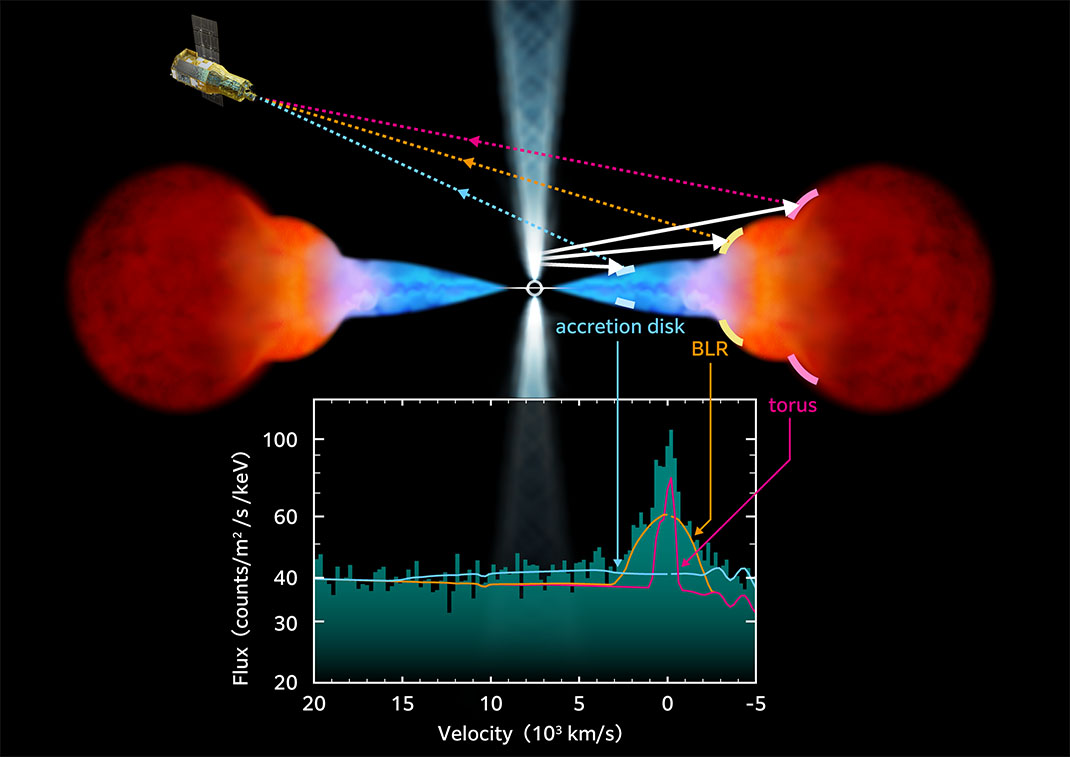Sep 20, 2024
Early Science Results from XRISM: Ultra-High Temperature Plasma in Supernova Remnants and the Structure Around Giant Black Holes
Keyword:RESEARCH
OBJECTIVE.
Following its launch on September 7, 2023, the X-ray Imaging and Spectroscopy Mission (XRISM) conducted the initial functional checking and performance verification (PV) observations, which has continued for about 6 months since February 2024. Here we highlight two initial results from the PV observations, papers on which have been accepted for publication in academic journals.
Key points:
- XRISM has revealed that the temperature of iron ions has reaches 10 billion degrees Celsius in a supernova remnant.
- XRISM has determined the inner radius of a molecular torus around a supermassive black hole to be approximately 0.1 light-years.
Both supernova remnants and supermassive black holes generate "winds" that circulate matter and energy throughout galaxies. These winds play crucial roles in the evolution of the Universe. XRISM’s findings offer important insights into these circulation processes.

Illustration of Seyfert galaxy NGC 4151 based on XRISM observations and past observations. Disk wind is illustrated. Credit:JAXA
1. Supernova Remnant N132D: Unveiling Ultra-High Temperature Iron

Caption: X-ray image and spectrum of the supernova remnant N132D from XRISM’s First Light observations. The image was captured by XRISM’s Xtend instrument, while the high-resolution spectrum was obtained using the Resolve spectrometer. Credit: JAXA
This measurement has been enabled by XRISM’s capability in capturing the "thermal Doppler effect," which occurs as ions within the supernova remnant move due to thermal motion, causing their characteristic X-ray wavelengths to shift. By analyzing this Doppler effect, XRISM revealed that while outer regions of the remnant are cooler (~10 million degrees Celsius), the iron deep inside has been superheated by powerful shock waves to reach 10 billion degrees. This result is the first observational confirmation of such high temperatures for iron in a supernova remnant, providing a new window into the energy circulation in the Universe.
2. Black Hole Surroundings: Mapping the Structure Around NGC 4151

Caption: XRISM/Resolve spectrum of iron characteristic X-rays from NGC 4151 in velocity space, revealing the inferred structure of matter surrounding the black hole. The spectral broadening indicates multiple regions, including the molecular torus, the broad line region, and the accretion disk. Credit: JAXA
XRISM's observations focused on the "molecular torus"; a dense ring of gas and dust that encircles the black hole. Using its superior spectroscopic capabilities, XRISM determined the inner edge of this torus lies about 0.1 light-years from the black hole. Additionally, the satellite was able to map the distribution of matter within the black hole's accretion disk and the so-called broad line region, which extends from the black hole's vicinity outward.
These measurements were made by analyzing the Doppler shifts caused by matter orbiting the black hole at high speeds. The research team used this technique to map different regions surrounding the black hole. These results provide new insights into how matter spirals into black holes and how this process affects galaxy evolution.
Current Status and Future Prospects
An open call for guest observation program was conducted from November 2023 to April 2024, resulting in the selection of 104 proposals from researchers worldwide, including those from the Japan Aerospace Exploration Agency (JAXA), the United States National Aeronautics and Space Administration (NASA), and the European Space Agency (ESA). The accepted proposals can be found on the XRISM website for researchers.
The research results highlighted in this article will be published in upcoming academic journals. XRISM's initial findings exceed expectations and pave the way for a deeper understanding of the cosmos.
- Title: The XRISM First Light Observation: Velocity Structure and Thermal Properties of the Supernova Remnant N132D
- Authors: XRISM Collaboration
- Journal: Publications of the Astronomical Society of Japan
- Title: XRISM Spectroscopy of the Fe Kα Emission Line in the Seyfert AGN NGC 4151 Reveals the Disk, Broad Line Region, and Torus
- Authors: XRISM Collaboration
- Journal: The Astrophysical Journal Letters